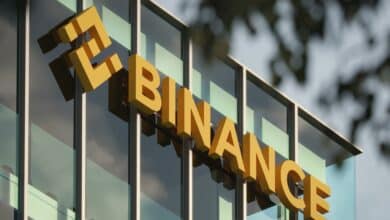What are Blockchain Nodes? A Complete Guide

Introduction
Before the 90s most people had no idea what is internet and how it works. In the same manner, today many people are not familiar with what a blockchain is and how it operates.
To understand the blockchain and its inner working, investors must take the reductionist approach. This article is going to talk about node which is an important component necessary to create a blockchain network.
What is Blockchain and How Does it Work?
A Blockchain is a decentralized financial network that is based on the principles of Distributed Ledger Technology or DLT. In essence, blockchain is like a digital financial ledger where all the activities and transactions of every user on the network are stored.
All the users on a blockchain can access and verify every single transaction record for reconciliation. This mechanism ensures that the blockchains can remain decentralized and keep operating without the danger of foul play or data manipulation.
To make sure that all the users have a verified copy of every single transaction happening on the blockchain, it uses nodes. Nodes are protocols where the transaction records are received and recorded for every single user.
The record of every new transaction is present on a block and each block can contain millions of transactions. Nodes are the main reason that blockchain data cannot be changed or manipulated because no hacker can change the records on thousands of nodes at the same time.
The blockchain is always going to check the manipulated data with other nodes and discard the wrong information in favor of the correct records.
What are Nodes?
A node is a network point that is used as a distribution junction for other nodes or it presents the endpoint of the said network. Usually, blockchain nodes are interconnected with millions of other nodes for correspondence and reconciliation purposes.
Blockchain nodes are not essentially software alone; they can also be present in the form of hardware that is acting as storage units or servers for them. At the same time, there is also a software-based digital network of nodes present in every blockchain.
In other words, a node is a point where new messages can be created, received, recorded, and transmitted. When it comes to a blockchain network, the hardware devices such as PCs, laptops, and servers can be thought of as nodes. The functions of nodes in the blockchain networks are multifaceted.
Nodes perform the tasks of saving, storing, rejecting, and reconciliation of transaction records. Nodes can contain complete transaction history from a blockchain. Furthermore, they are also charged with the important task of transferring important data to other nodes.
Why does Blockchain Need Nodes?
To understand the importance of nodes on a blockchain network, it is important to understand the process of financial recording on blockchain nodes. The first step for the verification of a transaction on a blockchain is done by users. The users employ their private and public key combinations to lock the transaction with an encryption key.
When this encryption code is solved by miners, the nodes on the blockchain send this information to every user using the nodes’ network. When a majority of the nodes on the network validate the said transaction, it is added to the main chain of blocks or blockchain.
In the same manner, new transaction updates are also done by sending a copy to all nodes to complete the cycle of the transaction. Here are some of the most important functions that nodes can use on a blockchain network:
- To add or reject a new transaction.
- Validating the existing transaction and managing the transaction record history.
- Store and encrypt the transaction data within a block.
- Act as a bridge for data transfer for all the nodes present within a blockchain ecosystem.
- Make communication and all other types of data transfer possible for blockchain users.
Types of Nodes on Blockchain
It is important to note that a blockchain is a complex digital financial network. Therefore, it consists of several types of nodes at a given time.
Therefore, the functions of different nodes existing in a blockchain network can differ from each other and some of these nodes can act as standalone systems that perform very specific set of functions.
The features and composition of nodes depend on the development architecture and intended uses of the blockchain network in question. Here are some of the most common types of nodes that can be found within a Blockchain network:
Full Nodes
Full Nodes contain all the information contained on a blockchain network. It means that they are like the backbone or a comprehensive transaction record present on a blockchain network. Full nodes can contain millions of unique transactions.
PoW and PoS consensus models require the verification of every new transaction with its Full Node source. Therefore, Full nodes are often attributed to taking an active part in the governance of a network. Full Nodes are divided into two further types:
Pruned Full Node
A Pruned Full node work by storing all the block data on a hard disk using the pruning method from existing blocks. They take up a specified amount of storage space. It means that these nodes have to download the complete block record on a hard disk and delete any older data records.
It means that Pruned Full Nodes make room for new transaction records by deleting older transaction records depending on their available storage capacity. It is also synced with the blockchain network in real-time to keep updating records.
Archival Full Node
As visible from their names, Archival Full Nodes can keep a record of every single blockchain transaction at all times. Their storage limit is very big or undefined. Since it warrants greater data-sourcing capacity; therefore it is a more common way of storing blockchain nodes. Archival Full Nodes can be divided into further 4 types as under:
Masternodes
Masternodes cannot add a new block to the blockchain network. Therefore, they are used for validating and recording transactions on the blockchain alone.
On the other hand, they are also used for performing some additional functions added by the developers that are specific to them. Dash blockchain first incorporated Masternodes in 2014.
Mining Nodes
Mining nodes are often seen as one of the most important features available on a blockchain network. Within the PoW model, these nodes can contain complex encryption puzzles that miners need to solve using computing power.
The mining nodes can require a considerable amount of computation power and electricity supply. The miners can earn mining rewards in the form of token issuance for solving these mining nodes.
Staking Nodes
Staking Nodes are an alternative to the mining nodes that works for a PoS consensus model. Stakers are required to lock a specified amount of cryptocurrency native to the blockchain to become a validator. In this manner, the blockchain can deploy the Staking Nodes to process transactions and create new records on the DLT.
The selection of a validator is based on rules in a network such as the total amount of locked funds and active time spent on the blockchain. Staking nodes require lesser energy and computation power in comparison to Mining Nodes.
Authority Nodes
Public blockchains allow anyone to become a node by downloading the blockchain and synching it with the on-chain data stream. On the other hand, with Private Blockchains access to on-chain information is restricted and it is done using Authority nodes.
Some partially centralized blockchains can also incorporate Authority nodes to limit free access.
Lightweight Nodes
Lightweight or Light Nodes are faster in comparison to Full Nodes. These nodes can decrease transaction time and reduce the period for daily activities. They are also referred to as Simplified Payment Verification or SPV nodes.
Rather than downloading and storing the whole blockchain data these nodes are designed to pick only highlights such as block headers. In this manner, they can work as the “Lite” version of a typical block and save storage space as well.
Supernodes
Supernodes are comparatively rare types of nodes within the blockchain space. They are created to perform special functions and highly specialized tasks.
Some blockchains can introduce unique functions like regulations maintenance or implement an upgrade with Supernodes.
Lightening Nodes
There are several occasions when a blockchain network can become overloaded with users. Under such circumstances, the users on the network can face slower transactions and lags. Therefore, Lightening Nodes are introduced to decrease latency to complete the transactions faster.
These nodes can also enable off-chain transactions as a bridge between the mainnet and outer nodes. They can also work to reduce the load on a blockchain in this manner the transactions are faster and require smaller gas fees.
Comparison of Node Networks in Bitcoin, Ethereum, and Cardano Network
Bitcoin network contains around 11,500 nodes in total. With new downloads and new transactions, the number keeps increasing every month with consistency since the formation of the first block.
It is important to note that there are no formal mechanisms to measure the exact number of total Bitcoin nodes at any given time. Several Bitcoin nodes operate privately while there are others that are inactive or offline. Running Bitcoin nodes can increase security and improve privacy for the user.
Ethereum nodes are very similar to Bitcoin nodes based on their underlying design. As per careful estimates, the total number of Ethereum Nodes is higher in numbers than Bitcoin nodes.
Ethereum nodes can be executed by programmers with extensive technical knowledge. There are three node running modes namely full, fast, and light on Ethereum. The user is also required to fulfill 8MB bandwidth, 4 GB RAM, and dual-core PC. Ethereum Nodes are also more complicated to run in comparison to Bitcoin nodes.
The Cardano network was founded by one of the co-founders of the Ethereum blockchain. The Cardano blockchain uses top-level nodes with a slightly upgraded topology.
The Cardano nodes do not store the whole copy of transaction history on each new node such as Bitcoin and Ethereum.
On the other hand, the node network is operated under the supervision of a selected leader by the system. The leader is charged with node collection, verification, and validation of transactions on Cardano nodes.
How to Run a Node?
Every blockchain network can use a different set of requirements and operational criteria for running its nodes. However, by using the example of the Node running process on Bitcoin, investors can get the basic idea.
Bitcoin node runners can need the latest version of a laptop or PC that contains an updated Windows, MAC, or Linux operating system. The user is also going to need an active internet connection with a minimum bandwidth of 400 KB. The node running time is set to be 6 hours per day.
The user can download and configure the Bitcoin Core on their system to run it. It will take a few days to sync with the Bitcoin blockchain. An alternative method is to run nodes on Cloud storage. For this, the user is going to need an account on Google Cloud or AWS.
They will then download the Bitcoin Core inside their Google Cloud account and configure the port settings on their local machine. There are many ways to go about running nodes on Bitcoin, for example, pre-configured nodes that are already connected to your local machine.
A third alternative for a running node is to use a node-in-a-box solution that entails building the hardware from scratch manually.
What are Blockchain Node Providers?
Anyone can download and run Bitcoin nodes in their capacity. However, most users are likely to face technical issues and might want to get some assistance in this regard. Some companies offer Blockchain as a service.
These companies are called Blockchain Node Providers. They can offer help with infrastructure, technical resources, walkthroughs, and other technological plugs to help the users to run the nodes on various types of software and hardware combinations.
The responsibility to troubleshoot and carry out the process of node run is delegated wholly to the Blockchain Node Providers. The client of these services can select any network based on their preferences to run the node.
There are some important points that the user should keep in mind when they are thinking about working with a Blockchain Node Provider.
The first factor to consider is the consultation fees for these node operators. Furthermore, the user should also read reviews to make sure that the node provider has a solid security protocol.
Any crack in the security of the network can have detrimental financial consequences for the node runners. Another important aspect to check is to ensure their track record. The users should also research in advance whether the service offer is compatible with their local machine and hardware for the node running.
What are the Basic Functions of Blockchain Nodes?
It has been established that blockchain nodes are an integral part of every DeFi ecosystem. Every blockchain has a unique combination of nodes with a different set of features assigned to them. However, to learn about blockchain nodes, investors must take a look at these most important functions that nodes offer:
Maintenance
Blockchains are inherently decentralized which means that they are not stored in a singular or private server. To remain decentralized blockchains need nodes to remain operational.
Furthermore, the blockchain needs to keep updating the new transaction record while keeping the older records safe from the danger of manipulation. Blockchains like Bitcoin and Ethereum depend on several thousand nodes to store their transaction histories across the globe.
Transaction Validation
Some nodes are part of the native consensus mechanisms for these blockchains. Therefore, they are vital for the transaction validation process and some others are responsible for recording transactions alone.
These validating nodes receive every new transaction order to check authenticity to approve or reject it. There are some blockchains where validator nodes can play the role of governance protocol and take part in voting for major decisions for the network.
Information Access
Nodes ensure that the blockchain is not only secure and organized but also transparent at the same time. In a public blockchain, all the participants can check every single transaction record that happened on the network.
With private blockchains, enterprises can ensure that all the transaction records are present in an authentic manner. There are some third-party blockchain explorers such as EtherScan that users can employ to access on-chain information on the Ethereum blockchain.
Conclusion
Nodes can be seen as one of the building blocks of a blockchain network. Both technical and non-technical users need to learn about blockchain nodes if they are only interested in investing in them.
By learning more about the inner functions and basic classification of nodes, investors can make better decisions about the fundamental assessment. Developers also need to learn about different node mechanisms to create new DApps.
Tokenhell produces content exposure for over 5,000 crypto companies and you can be one of them too! Contact at info@tokenhell.com if you have any questions. Cryptocurrencies are highly volatile, conduct your own research before making any investment decisions. Some of the posts on this website are guest posts or paid posts that are not written by Tokenhell authors (namely Crypto Cable , Sponsored Articles and Press Release content) and the views expressed in these types of posts do not reflect the views of this website. Tokenhell is not responsible for the content, accuracy, quality, advertising, products or any other content or banners (ad space) posted on the site. Read full terms and conditions / disclaimer.







